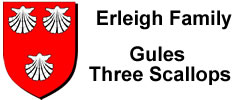CHAPTER THREE.
THE EARLES OF DEVON.
We have seen the original Earle stock in Somerset sending shoots across the border into the neighboring counties of Wiltshire and Gloucester. This was quite natural, as the family estates at Beckington were almost on the boundary line between Somerset and Wiltshire and no great distance from Bristol. And we are now to see a scion of this same stock transplanted into the county of Devon, the next neighbor of Somerset on the west.
There seems to be some obscurity as to the exact time when this migration took place.
In his “History of Dorsetshire,” Hutchins says: “The Erles were a very ancient and knightly family. The first that occurs in the pedigree is Henry de Erle (1251), lord of Newton, County of Somerset. They were subsequently styled of North Petherton, in that county, and seem afterward to have removed to Culhampton, County Devon.”
This does not fix any date for the removal to Devon; further, it was subsequent to Henry de Erleigh, who was the sixth of the Somerset succession. Some have been led to identify Henry’s son, John, with John Erle, of Ashburton and Culhampton, Devon, but this is probably an error.
The London writer before quoted says: “One branch of the Somerset Earles settled in the County of Devon, in the time of Edward the III. (1327-1377), as I find John Erle holding lands at Ashburton, twenty miles from Exeter, and bearing the same arms as his Somersetshire ancestor, viz: Gules, 3 escallops, argent, within a bordure, engrailed, argent!
As the first allusion to a coat of arms is in connection with the history of John de Erleigh (G8), the eighth in the above succession and the grandson of Henry de Erleigh, this passage would seem to bring John Erle of Ashburton, several generations later. He is evidently a son of a younger son, as the eldest sons are in the Somerset succession.
Now “The White Knight,” Sir John de Erleigh had three younger sons, Robert, Richard, and Philip, and one of these may have been the father or grandfather of John Erle of Ashburton. In fact, this is the descent of the progenitor of the Devon branch as given by Sir Henry Earle, Bart., the highest authority on the history of the English Earles. The only point of conflict with the London writer quoted from is that the latter places John Erle, of Ashburton, in the time of Edward III., that is, not later than 1377, whereas Sir Henry gives 1484 as the date of his death, which would make him more than 100 years old.
Not being able to resolve this difficulty, we shall accept the account given by Sir Henry Earle, Bart., of the origin of the Devon
family.
The genealogy is as follows, beginning with John de Erleigh.
Wikitree Profile: https://www.wikitree.com/wiki/DeErleigh-3
The Devon Branch
(J) THE TENTH GENERATION.
CHILDREN OF SIR JOHN de ERLEIGH (I10), “THE WHITE KNIGHT,” (b. 1334; d. 1410), AND MARGARET, daughter of Sir Guy de Brien:
- J 2) ROBERT de ERLEIGH.
- J 3) RICHARD de ERLEIGH.
- J 4) PHILIP de ERLEIGH.
(K) THE ELEVENTH GENERATION.
A son of Robert, Richard, or Philip de Erleigh, sons of the “White Knight.”
- K 1) (Probably) ROBERT de ERLEIGH.
(L) THE TWELFTH GENERATION.
CHILDREN OF ROBERT (?) de ERLEIGH:
- L 2) JOHN ERLE, d. 1484, of Ashburton and Culhampton, Devon; married Margaret de Sondes (L 1), died 1472.
(M) THE THIRTEENTH GENERATION.
CHILDREN OF JOHN ERLE (L 2), OF ASHBURTON, AND MARGARET DE SONDES (L 1):
- M 1) ROBERT EARLE, of Compton, Somerset, d. 1517; ancestor of the Earles of Wiltshire.
- M 2) JOHN EARLE (or Erle), of Culhampton, Devon, (d. 1508); ancestor of Devon, Dorset, Winchester, Southampton, Essex, and Nottinghamshire branches.
Thus far on the authority of Sir Henry Earle. We may now quote again the London genealogist already referred to, whose statements seem, in the main, to fit into the above:
“This John Erie’s (L2) second son (M2) held lands at Culhamp- ton, in the County of Devon, twelve miles from Exeter, and was succeeded in them by his son and heir, John Erle, who married Thomasine Beare, of the County of Somerset, and by her had a son, Walter, who married Mary, daughter, and co-heir of Richard Wykes, of Binden and Charborough, both in the County of Dorset.”
“From the Erles of Devon are descended the Erles of Hants(Hampshire), Lincolnshire, London, Berkshire, and Essex.”
“The elder son of John Erle, who first settled at Ashburton, County of Devon, and his descendants for several generations, continued to reside in that county. There are many lines of the Earles all springing from a common ancestor with him who first settled in Devonshire, and when perfected, the Earle pedigree would prove a valuable and interesting genealogical history.”
These statements call for one or two remarks. It is undoubtedly true that many lines of Earles have sprung from a common ancestor in Devon, but whether the descent of all of those named can be definitely traced is open to question. The list given by Sir Henry under John Erie (M2) of Culhampton, is later and is supported by evidence.We are glad to think that all the Earles of England, and therefore of America, are descended from the main original line we have been considering, but in many cases, the proof of connection is lacking.
It is also true that the descendants of John Erle, of Ashburton, remained for generations in Devon. These constitute the Devon Earles. But the statement regarding his elder son, Robert Erie (M1), is probably incorrect. He was of Compton, Somerset, and became the ancestor of the Earles of Wiltshire.
One other quotation completes our knowledge of the Earles of Devon:
“The ancient armorials, as originally borne, are as follows: ARMS, Gules, 3 escallops, argent, within a bordure engrailed of the last. CREST, a lion’s head erased or, transfixed with a spear, argent, embrued, gules.”
